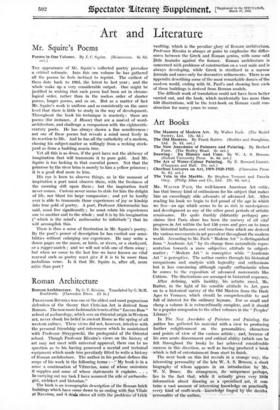Roman Architecture
Roman Architecture. By G. T. Rivoira. Translated by G. McN. Rushforth. (Clarendon Press. £5 5s.) PROFESSOR RIVOIRA was one of the ablest and most pugnacious defenders of the theory that ChrisLian Art is derived from Roman. The now more fashionable tenets of the "Los von Rom" school of archaeology, which sees an Oriental origin in Western art, never shook his belief in ancient Rome as the spring of all western culture. - These views did not, however, interfere with the personal friendship and intercourse which he maintained with Professor Strzygowski, the protagonist of the Oriental school. Though Professor Rivoira's views on the history of art may not meet with universal approval, there can be no question as to his having. possessed a mental ,and technical equipment which made him peculiarly fitted to write a history of Roman architecture. The author in his preface defines the
scope of his work in the following terms My book is in a sense a continuation of Vitruvius, some of whose omissions it supplies and some of whose statements it explains.. . . In carrying out my .task I have assumed the role of archaeolo- gist, architect and historian."
The book is an iconographic description of the Roman brick building's which have come down to us ending with San Vitale at Ravenna, and it deals above all With the problems of trick vaulting, which is the peculiar -glory of Roman architecture. Professor Rivoira is. always at pains to emphaiize the differ- ences between the Greek.and Roman genius, with some odd little boutades against the former. . Roman architecture is concerned with problems of construction on a vast scale and is always developing, while Greek is sterilized- in a • narrow formula and cares only for decorative refinements.- There is'an appendix describing some of the, most remarkable donieS of the modern world, ending with St. Piturs and showing how each of these buildings is derived from Roman models.
The difficult work of translation could not have been-better carried out, and the book, which incidentally has more than 350 illustrations, will be the text-book on Roman vault con- struction for many years to come.






















































 Previous page
Previous page